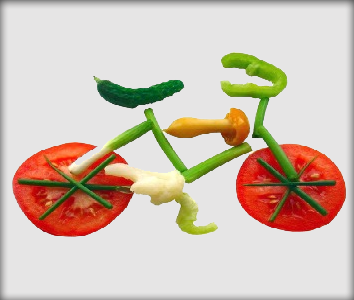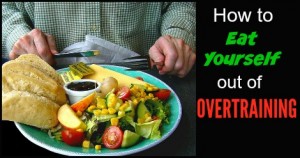 Losing or maintaining weight is usually a goal that ranks pretty high on a runner’s priority list. Whether it be for optimal performance, general health, or even the reason they started running in the first place, weight is a critical issue for runners.
Losing or maintaining weight is usually a goal that ranks pretty high on a runner’s priority list. Whether it be for optimal performance, general health, or even the reason they started running in the first place, weight is a critical issue for runners.
Unfortunately, despite how it may seem, losing weight and training hard aren’t easy to do in conjunction.
If you understand the basic principles of weight loss, you recognize that the most critical factor in weight loss is incurring a calorie deficit. To do so, not only do you have to measure portion sizes, but you have to control the quality of the foods you consume; specifically, limiting your intake of simple carbohydrates. This is why low-carb diets are effective.
However, on the opposite spectrum, to train hard and recover quickly from difficult workouts, a runner must consume adequate calories and fuel with complex carbohydrates (and even simple carbohydrates at the right times). Being in a constant caloric deficit and not providing the muscles with the right type of fuel will leave you tired, struggling to recover, and will derail your performances.
So, what’s the solution if you’re a runner who wants to balance training hard and running well with losing weight?
Perhaps we can look again to bodybuilders for an answer. By modifying the time-tested bodybuilding strategy of carb-cycling to the specific metabolic and training demands of runners, it’s possible to attain that delicate balance between weight loss and optimal performance.
What is carb-cycling
Simply speaking, carb-cycling is a process of alternating between lower carbohydrate, lower calorie days and higher carbohydrate, higher calorie days.
These cycles are usually a couple of days long and are usually based on the days in which you train. Bodybuilders will often use severe carbohydrate and calorie restrictions on their “non-carb” days and load up on their “high carb” days. Unfortunately, these extremes won’t be quite as effective for runners because the energy systems required for optimal training are different between weight lifters and runners. However, we can modify the process to get the benefits we as runners need. But first we need to understand the basics of how carb-cycling works.
How carb-cycling works
To better understand why carb-cycling works it’s important that you understand the role carbohydrates, or lack thereof, play in weight loss.
Mainly, we know that limiting carbohydrate intake lowers insulin levels. Research shows that having low insulin levels accelerates the release of fatty acids and increases fat burning, even during exercise (which is where the idea of running before eating breakfast to burn fat comes from). Considering this information about the role of carbohydrates and insulin, if a runner wants to burn fat and lose weight, they would refrain from eating carbohydrates all together.
But we also have to take into consideration the idea of recovery and fuel for maximum performance.
Insulin is a very important hormone in the metabolic energy and recovery process. Insulin facilitates the transport of glucose from the blood into the muscle cell, where it can be metabolized to produce energy. Meanwhile, carbohydrates and insulin also stimulate the recovery process by driving critical nutrients, including protein, to damaged muscles. Therefore, it is critical athletes include carbohydrates in their diet; specifically, before and after workouts, which are the most critical time windows for running performance and recovery.
Carb-cycling, when done correctly, facilitates this objective by ensuring that the liver or muscle tissue rapidly absorbs any ingested carbohydrates to replenish glycogen stores. If ingested carbohydrates replenish glycogen stores, there won’t be an excess that end up in fat cells where enzymes convert glucose into fat for storage, thus allowing you to lose weight.
The effectiveness of carb-cycling
Recent research conducted by the Genesis Prevention Center revealed that intermittent, low-carbohydrate diets were superior to the standard, daily calorie-restricted diet and the traditional Mediterranean diet in reducing weight, body fat and insulin resistance.
In short, mean reduction in weight and body fat was roughly 4 kilograms (about 9 pounds) when implementing carb cycling compared with 2.4 kilograms (about 5 pounds) with the standard dietary approach.
The researches also found that insulin resistance was reduced by 22 percent with the restricted low-carbohydrate diet compared to 4 percent with the standard Mediterranean diet.
How to modify carb-cycling for runners
The issue with traditional carb-cycling is that it’s pretty extreme and often difficult to follow. Unlike weightlifters, runners usually train 5-6 days per week. Moreover, weightlifters mostly rely on short, alactic bursts of energy while runners require a fairly constant supply of glycogen. Therefore, a runner can’t severely restrict their calorie and carbohydrate intake without suffering mightily on their runs, which will also bleed into subsequent workouts.
Instead, runners can breakdown the carb-cycle process to better coincide with the continued energy demands of distance running. Rather than approach carb-cycling with the all-or-nothing tactic weight lifters implement, runners can employ a carb-cycling methodology that utilizes no carb, low carb, and high carb days that correspond with specific training days.
Maintaining this type of carb-cycle approach will enable a runner to specifically target days when carbohydrates and calories are needed for performance and recovery while still allowing for the calorie and carbohydrate deficit needed to lose weight.
No carbohydrate, low calorie days
These will be the rest or cross training days of your training schedule. If you run more than 5 days per week, substitute your easiest run of the week for the off day. You’ll want to target a caloric deficit of about 400 to 600 calories on your low carbohydrate day.
The no carbohydrate phase should breakdown to: 1.2 grams of protein per pound of bodyweight, .4 grams of fat per pound, and .5 grams of carbohydrates per pound.
For a 130lb woman, here is what the numbers would look like:
Protein – 130lb x 1.2 = 156g protein = 624 calories (46% of caloric intake)
Fat – 130lb x 0.4 = 52g fat = 468 calories (34 % caloric intake)
Carbohydrate – 130lb x 0.5 = 65g carbs = 260 calories (19% caloric intake)
Given a normal 130lb woman burns about 1900 calories per day, this would result in a 550 calorie deficit, just what you need for weight loss.
Low carbohydrate, moderate calorie days
Low carbohydrate days are your average training day and are the main driver of carb-cycling for running. These days allow you to maintain the energy reserves to run well while giving your muscles fuel for recovery. Low carbohydrate days should be 3-4 days per week that are running days, but not your hardest workouts or long runs.
The low carbohydrate phase should breakdown to: 1.3 grams of protein per pound, .5 grams of fat per pound, and 1.0 grams of carbohydrates per pound.
For a 130lb woman, here is what the numbers would look like:
Protein – 130lb x 1.3 = 169g protein = 676 calories (38% of caloric intake)
Fat – 130lb x 0.5 = 65g fat = 585 calories (33 % caloric intake)
Carbohydrate – 130lb x 1.0 = 130g carbs = 520 calories (23% caloric intake)
While still relatively low in carbohydrates, this results in roughly the same number of calories burned as calories consumed, which will help fuel running without putting on weight.
High carbohydrate, high calorie days
High carbohydrate days will be your hardest workout days and long run days. Typically, you’ll have two or three per week, depending on the intensity of your schedule. The additional calories and carbohydrates should come from complex carbohydrates and be eaten before and after your run for optimal fueling. The purpose is to replenish the body’s glycogen stores, stimulate an anabolic response through insulin release, and give the mind a break from the moderately restrictive normal phase of the diet. The basic idea is to continue to eat a lot of veggies and add to that unlimited fruit, unlimited natural unprocessed carbohydrates, and if necessary, a small amount of processed carbohydrates.
The high carbohydrate phase should breakdown to: 1.7 grams of protein per pound, .5 grams of fat per pound, and 2.5 grams of carbohydrates per pound.
For a 130lb woman, here is what the numbers would look like:
Protein – 130lb x 1.7 = 221g protein = 884 calories
Fat – 130lb x 0.5 = 52g fat = 468 calories
Carbohydrate – 130lb x 2.5 = 325g carbs = 1300 calories
If you’re struggling to lose weight while maintaining a rigorous training schedule, give carb-cycling a try. Like anything with running, it’s not easy and it requires work and planning, but the results will speak for themselves.
RunnersConnect Bonus Extra
Get the only runner’s calorie calculator that factors in your metabolism and the miles you ran to help you determine exactly how many calories you burned each day. Plus, get a breakdown of how many calories you need to eat (including how many carbs, proteins and fats you should target) to lose weight.




8 Responses
Hi. I was told that it takes 2-3 days for glucogen to build up in muscles. If that is true, wouldn’t that meal that a high carb day should be the day before a long run? Please set me straight.
Car-cycling has nothing to do with being ready for a long run. It’s about managing carbohydrate consumption to lose weight. You’re thinking of carb-loading: https://runnersconnect.net/running-nutrition-articles/carbohydrate-loading-marathon/
Could you post a typical day of meals for each low, moderate, and high carb day?
I’ve been following this and lost a few pounds – so thankful for! But I keep bonking on my long runs (15-20 milers. I haven’t had that problem before). I think I need higher carbs the day before a long run. Even if I eat carbs the morning of – it doesn’t seem to be enough.
Hi Kathy, you would benefit greatly from checking out our marathon nutrition blueprint. We would calculate your exact needs, and make it easy for you to never bonk again https://nutrition.runnersconnect.net
We also have a few articles you may enjoy reading: https://runnersconnect.net/running-nutrition-articles/bonk-fatigue-cramp/ and https://runnersconnect.net/running-nutrition-articles/practice-long-run-nutrition/ https://runnersconnect.net/running-nutrition-articles/should-i-eat-before-i-run-how-to-fuel-your-body-for-any-running-workout/
Hope this helps!
Thank you!! Great article and exactly the info I needed to tweak my diet to allow me to run again at least 3x a week but also continue with my weight training program. I will try this approach next week
Happy to help Stephanie! Anything else we can help you with?
Hello Tina! I tried to post my own comment but it kept signing me out 🙁 Three questions: 1) If we have an easy run the morning after a low carb day (we’re talking 4:30AM) should most of the carbs on that low carb day be in the evening to restock for the next days runs? 2) Are the carb amounts “net” carbs, after fiber is taken out or just regular carb count? Does that make sense? C) Will this plan help a 130lb 30y/o female lose weight? Thanks in advance!